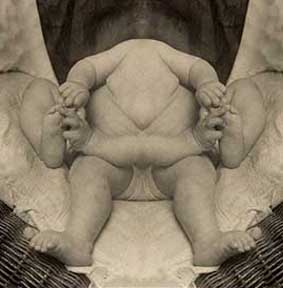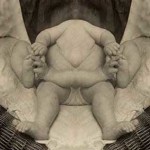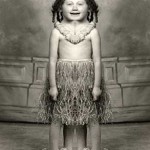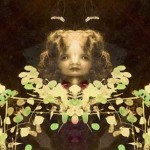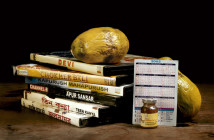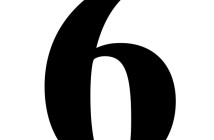Snapshots and studio photographs both represent a cultural norm of either actual or imagined American history. One represents the everyday and the the latter dignifies the celebratory events that punctuate the everyday. A family album is its own cabinet of curiosity: everybody wants a peek under the cover. Some just want to compare the sameness of their own lives; others, to hazily spin romantic tall tales about the salt of the earth.
At the Paradise Lounge Gallery is a traveling exhibit of Mark Mothersbaugh's altered photographs, Beautiful Mutants. Mothersbaugh has created a collection of "corrected" images where each anonymous snaps have been digitally sliced and flayed down the middle, constructing a bizarre symmetry. Culled from a collection of vintage 19th and 20th century photographic prints (mostly the pedestrian kind - the ones piled high in a wicker basket at a flea market), the freakish nature of a perfect symmetry is all the more heightened from a slightly skewed centerline. In these pictures, we expect a mirror of our past, not a mirror of what we fear - a transgression on normality.
The prints are beautiful, but what they represent is pictorially grotesque. How are these vernacular pictures “corrected”?
Mr. Mothersbaugh is one of the architects of perhaps the most renowned electro-sleaze outfit from the 1980's - Devo. Originally an art philosophy, Mothersbaugh crafted Devo with Kent State University classmate, Gerald V. Castle in the haze of the National Guard opening fire on student protesters in 1970. In their eyes, modern culture was not a force of evolution, but a representation of de-evolution. Those ideas were later applied in the band Devo, spawning the mainstream hit, Whip It. The group came as a music/performance package that was beautiful, mostly because was so grotesque.
If you are one in the long line of art students who attend a drawing class, you learn that symmetry is regarded as one of many ways to exhibit beauty. Deeply ingrained in western philosophy, symmetry is highly sought in science and mathematics to articulate phenomena. These explanations of symmetry naturalize form. Therefore, recognizing the inherent beauty in symmetry should be accessible to everyone and desiring it represents a height in human aesthetic awareness. Implementing it has yielded a variety of results from cathedrals to toaster design, which are thought of as a good thing. The darker side is that has led to measuring human bodies, implementing a system of classification for weeding out symmetrically deviant individuals, whether it be eugenics or studies in human attraction.
If one is considered ordinary or normal, it is deemed that you have the requisite amount of flaws to fit in comfortably with the faceless average. A little more symmetry might change that. Some folks desire symmetry enough (since it is a height of aesthetic awareness) for a variety of makeovers to achieve a closer ideal. Today we have options. A haircut satisfies most, but hose who opt for more radical surgery to achieve an optimum balance of features, risk becoming overly corrected Deviate too far from the norm, and one risks becoming an unnatural beauty or a candidate for permanent display in the Mutter Museum.
Mothersbaugh's aesthetic treatment to vernacular images offers a retroactive facelift those who may have not had such options for change. Herein lies the irony of de-evolution. Flatly applying the proper aesthetic "corrects" their quaitness, but transforms them into the fantastic, the grotesque. The anonymous middle that is represented bodily in these discarded photos is now afforded digital opportunity for remeberence though extreme objectification - like those made famous by the sideshow circuit.
Links:
Mark Mothersbaugh
Club Devo
Eugenics
BBC - Love and Attraction
Mutter Museum
Kent State University shootings
"Beautiful Mutants" is on view until November 28th at THE PARADISE LOUNGE GALLERY at 967 Commonwealth Avenue.
All images are courtesy of the artist and the Paradise Lounge.

